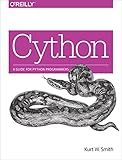Best Cython Integration Tools to Buy in December 2025
To provide bindings to C++ objects through Cython, you first need to create wrapper functions in Cython to interact with the C++ objects.
You can do this by creating a .pyx file with Cython code that defines classes and methods that mirror the functionality of the C++ objects. Within these classes and methods, you can call the corresponding C++ functions using the Cython cdef extern from syntax.
You will also need to compile the Cython code using a setup file that references the necessary C++ libraries and include files. This will generate a shared object file that can be imported into Python and used to interact with the C++ objects.
By providing bindings to C++ objects through Cython, you can take advantage of the performance benefits of C++ while still being able to access and manipulate the objects from Python.
How to implement callbacks from C++ to Python in Cython bindings?
To implement callbacks from C++ to Python in Cython bindings, you can use the following steps:
- Define a Python callback function in your Python code. This function will be called by the C++ code.
def my_callback_func(arg1, arg2): # Do something with the arguments pass
- Create a Cython wrapper for the callback function that will be called from the C++ code. This wrapper function will convert the arguments to Python objects and call the Python callback function.
cdef extern from "my_cpp_library.h": void my_cpp_function(void (*callback)(int, int))
cdef void callback_wrapper(int arg1, int arg2): my_callback_func(arg1, arg2)
my_cpp_function(callback_wrapper)
- In the C++ code where you want to trigger the callback, you can call the callback function using the function pointer passed to the Cython wrapper function.
void my_cpp_function(void (*callback)(int, int)) { // Do something callback(10, 20); }
- Ensure that you have the necessary setup in your setup.py file to compile and link the Python and C++ code using Cython.
- Compile your Cython code using cythonize() function in your setup.py file.
By following these steps, you can implement callbacks from C++ to Python in Cython bindings.
How to generate documentation for Cython bindings to C++ objects?
To generate documentation for Cython bindings to C++ objects, you can follow these steps:
- Write comments in your Cython code: Make sure to include detailed comments in your Cython code that describe the C++ objects, functions, and classes being wrapped. Use standard documentation formats such as reStructuredText or Markdown to ensure compatibility with popular documentation generation tools.
- Use Cython's annotations: Cython provides annotations that allow you to document types, functions, and classes in your code. These annotations can be used to provide additional information about the C++ objects being wrapped, such as parameter types and return types.
- Use Sphinx for documentation generation: Sphinx is a popular documentation generation tool that is commonly used in the Python community. You can use Sphinx to automatically generate documentation from your Cython code, including the comments and annotations you have added. Sphinx supports a variety of output formats, including HTML, PDF, and EPUB.
- Add a documentation build step to your build process: Once you have written comments, added annotations, and set up Sphinx for documentation generation, you can add a documentation build step to your build process. This step can be automated using tools such as Makefile, CMake, or a continuous integration service like Travis CI or GitHub Actions.
- Publish your documentation: Once you have generated the documentation, you can publish it online using services like Read the Docs or GitHub Pages. This will make it easy for other developers to reference and use your Cython bindings to C++ objects.
By following these steps, you can effectively generate documentation for your Cython bindings to C++ objects, making it easier for other developers to understand and use your code.
How to write a wrapper for a C++ class in Cython?
To write a wrapper for a C++ class in Cython, you will need to create a .pxd file to declare the C++ class interface and a .pyx file to implement the wrapper functions. Here is a step-by-step guide on how to write a wrapper for a C++ class in Cython:
Step 1: Create a .pxd file (e.g. MyClass.pxd) to declare the C++ class interface. Add the following code to declare the C++ class:
cdef extern from "MyClass.h": cdef cppclass MyClass: MyClass() except + void doSomething()
Step 2: Create a .pyx file (e.g. MyClassWrapper.pyx) to implement the wrapper functions. Add the following code to implement the wrapper functions:
cimport MyClass
cdef class PyMyClass: cdef MyClass.MyClass *thisptr
def \_\_cinit\_\_(self):
self.thisptr = new MyClass.MyClass()
def \_\_dealloc\_\_(self):
del self.thisptr
def doSomething(self):
self.thisptr.doSomething()
Step 3: Create a setup.py file to build the Cython extension module. Add the following code to the setup.py file:
from distutils.core import setup from Cython.Build import cythonize
setup( ext_modules = cythonize("MyClassWrapper.pyx"), )
Step 4: Compile the Cython extension module by running the following command in the terminal:
python setup.py build_ext --inplace
Step 5: Use the Cython extension module in your Python code by importing the PyMyClass class:
from MyClassWrapper import PyMyClass
my_obj = PyMyClass() my_obj.doSomething()
That's it! You have successfully created a wrapper for a C++ class in Cython. You can now use the Python wrapper class to interact with the underlying C++ class.
What is the process of exposing C++ methods to Python using Cython?
- Write a C++ class or a set of functions that you want to expose to Python.
- Create a .pyx file that will serve as a Cython interface for your C++ code. In this file, you will define functions that will act as wrappers for your C++ methods. These functions should have the same signature as the corresponding C++ methods.
- In the .pyx file, include the necessary Cython directives to interact with the C++ code. This may include importing the C++ header files, declaring C++ classes or functions, and specifying the type of objects that will be passed between Python and C++.
- Compile the .pyx file using Cython to generate a .cpp file.
- Compile the generated .cpp file along with your C++ code to create a shared library or a module that can be imported in Python.
- Import the module in Python and use the exposed C++ methods as if they were regular Python functions.
How to handle exceptions thrown by C++ methods in Python code using Cython?
To handle exceptions thrown by C++ methods in Python code using Cython, you can follow these steps:
- Use the except + statement in the Cython code to catch the exception thrown by the C++ method.
try: c_function() # Call the C++ method except +: # Handle the exception here print("Exception caught")
- Use the except block to catch specific exceptions thrown by the C++ method. You can specify the type of exception to catch using the except statement.
try: c_function() # Call the C++ method except MyCustomException: # Handle the exception here print("MyCustomException caught") except AnotherException: # Handle another specific exception here print("AnotherException caught")
- You can also handle exceptions thrown by the C++ method by converting them to Python exceptions.
try: c_function() # Call the C++ method except +: # Convert the C++ exception to a Python exception raise ValueError("C++ exception caught")
By following these steps, you can handle exceptions thrown by C++ methods in Python code using Cython.



